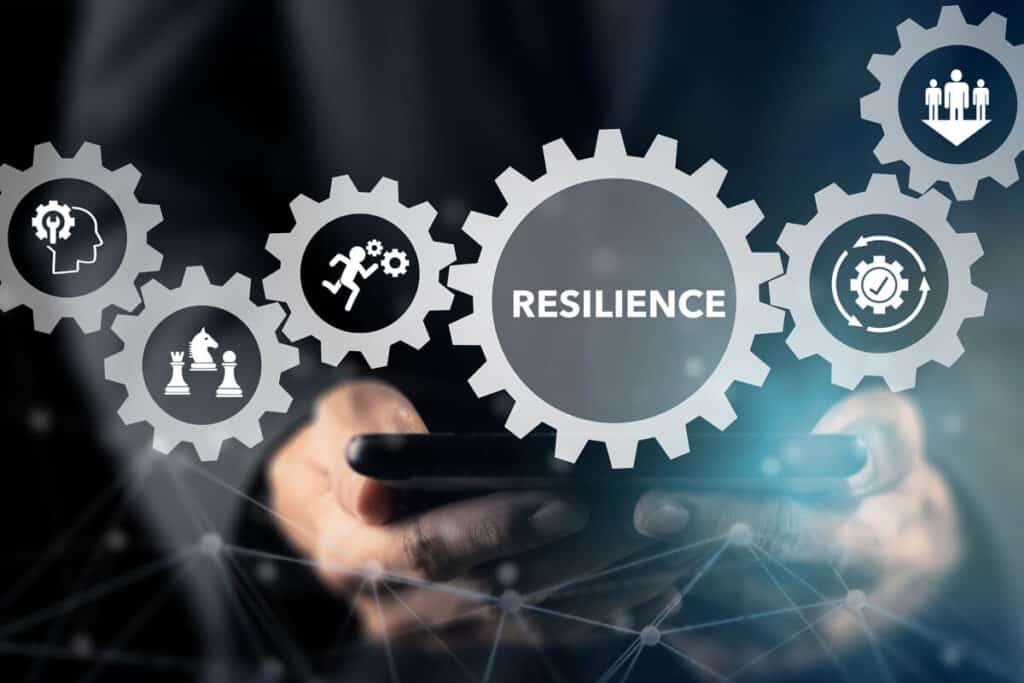Key highlights
- Using business continuity best practices is a good idea for organizations who want to maintain essential operations when disruption strikes.
- PwC’s Global Crisis and Resilience Survey revealed that 96% of business leaders have experienced disruption in the past two years.
- A third of organizations are not confident in their ability to respond to disruptions.
- Business continuity best practices include risk assessments, a robust continuity strategy, clear roles and responsibilities, resilient IT systems, employee training, regular testing, plan updates, IT disaster recovery planning, strong communication channels, and annual plan reviews.
Table of Contents
Toggle
Introduction
Every day, organizations face risks that can disrupt operations. Not just the big risks like severe weather, natural disasters, and pandemics – but also smaller but just as harmful and more likely risks like cyberattacks, IT failures, and transport failures that stop staff getting into work. If you want your business to survive when the unexpected happens, then the 10 business continuity best practices described in this blog will give you peace of mind.
Recent years have shown a rise in damaging events. According to PwC’s Global Crisis and Resilience Survey, 96% of business leaders experienced disruptions in the past two years, with 76% reporting medium to high impacts on operations. It’s no surprise that over 80% of executives prioritize organizational resilience. Are you in that 80%, or the 20% who don’t think it will happen to them?
A well-developed business continuity plan is crucial for organizations who want to keep their business operating. It provides a roadmap for responding and recovering from crises, minimizing downtime, and ensuring operational resilience.

What are the 10 business continuity best practices for success?
To achieve success, organizations should follow business continuity best practices. These include conducting risk assessments, developing a business continuity (BC) strategy, clarifying roles, ensuring resilient IT, prioritizing training, testing plans, updating them, establishing an IT disaster recovery plan, fostering communication channels, and reviewing plans annually. Read on to find out more.
1. Carry out a comprehensive risk assessment and business impact analysis.
The foundation for creating an effective business continuity plan (BCP) is to conduct a thorough assessment of risks to the business, followed by a business impact analysis to find out how much harm they could do. This process includes identifying all risks, analyzing their potential impact on operations, putting them in priority sequence, and designing mitigations for the highest impact and most likely risks. This helps to focus resources and effort where it can provide the biggest benefit.
The risk assessment should identify risks of all shapes and sizes, including threats like natural disasters, cyberattacks, supply chain disruptions, and loss of key staff. As well as listing the risks it’s best practice to record details including how likely the risk is to materialise, can it be prevented, and who might be impacted. A business impact analysis then evaluates the consequences of these risks on each business function, including financials, operations, reputation, and compliance.
2. Develop and implement a robust BC strategy
Developing a robust business continuity strategy requires a proactive mindset. The strategy should outlines steps to maintain essential functions at all times, including recovery objectives and required resources. Factors like risk tolerance, regulations, resources, and dependencies should be considered. Implementation of the strategy involves defining plans, communication protocols, resource allocation, and regular reviews for effectiveness against evolving threats and changes.

3. Assign Clear Roles and Responsibilities
Assigning clear roles and responsibilities is a key business continuity best practice, as this will help with smooth coordination and effective response when BC plans are activated.
Key roles in the business continuity best practices can include an emergency coordinator, a crisis management team, IT personnel for disaster recovery, communication coordinators, and department heads. These individuals ensure that critical decisions are made promptly and response efforts are coordinated effectively.
4. Ensure resilient IT systems and networks
IT systems and networks often experience failures. Resilient IT is crucial for uninterrupted business operations during disruptions. Redundancy can be achieved using designs like duplicate servers and network equipment, automated failover mechanisms, and event monitoring solutions. Implementing redundancy requires planning and investment in infrastructure. Using Cloud applications can be a very effective way to provide resilience and satisfy this critical aspect of business continuity best practices.
When resilience fails, well designed backup and recovery systems can help restore critical functions quickly and reduce downtime. Backup (secondary) data centers can be expensive to implement and maintain, but can ensure rapid return to operations after a failure.
No matter which solutions are used, organizations should assess critical functions, determine required redundancy levels based on recovery time objectives, and conduct regular testing for effectiveness and reliability.

5. Prioritize employee training and awareness programs
Prioritizing employee training and awareness programs is essential for ensuring continued operations. Employees play a critical role in implementing the BC plan and responding effectively to a crisis. By providing them with the necessary knowledge and skills, organizations can enhance operational resilience and minimize the impact of disruptions, including those caused by external service providers.
Key training and awareness areas in business continuity best practices include:
- Familiarity with the BC plan: Employees should be familiar with the organization’s BC plan, including their roles and responsibilities in implementing it.
- Emergency response procedures: Training employees on emergency response procedures, such as evacuation protocols, communication channels, and reporting mechanisms, ensures that they can respond promptly and safely during a crisis.
- Technology and system usage: Employees should receive training on the appropriate use of technology systems and tools, including backup systems, remote access, and data security measures.
- Crisis communication: Effective communication is crucial during a crisis. Training employees on crisis communication protocols, including how to deliver clear and timely messages to colleagues, customers, and other stakeholders, is essential.
Regular training sessions, drills, and simulations should be conducted to reinforce employee knowledge and skills. It is also important to promote a culture of awareness and preparedness, where employees understand the importance of BC and actively contribute to the organization’s resilience.
6. Regularly test and simulate the Business Continuity Plan (BCP)
Regularly testing and simulating the BCP is crucial to identify gaps, weaknesses, and areas for improvement. A variety of methods including tabletop exercises, walk-throughs, and simulations can be used to validate the plan’s effectiveness, readiness of teams, and IT recovery capabilities. Simulations help evaluate responses in different scenarios, train employees on their roles, and enhance overall response capabilities. Scheduled testing, reviews, and updates are vital to maintaining plan relevance amidst evolving threats and organizational changes., ensuring that all business units are prepared in case of a disaster.
7. Keep the plan updated with emerging threats and changes
Threats continually change. Keeping the BCP updated is crucial for addressing emerging threats and changes effectively. The business landscape evolves continuously, bringing new risks and challenges. Organizations must proactively review and update their plans to adapt.
Emerging threats like cyber threats or regulatory changes can disrupt continuity. By monitoring and integrating these threats into the plan, organizations can be well-prepared to respond if needed.
Regular updates should also reflect changes in operations, infrastructure, and personnel to maintain relevance and effectiveness. By staying updated, organizations can remain resilient and ensure operational continuity during disruptions.
8. Establish a detailed IT disaster recovery plan
An IT disaster recovery (DR) plan is a critical component of the overall business continuity strategy and is one of the essential business continuity best practices for any organization that relies on IT. A DR plan focuses on restoring IT infrastructure and operations after a crisis to ensure the continuity of business functions.
The IT disaster recovery plan should include key information such as:
- Notification communication plan: A clear and efficient communication plan to notify relevant stakeholders about the disaster and its impact.
- Staff relocation: Procedures for relocating IT staff to alternative facilities or remote locations to ensure the continuity of IT operations.
- Alternate resources: Identification of alternate resources, such as backup systems, data centers, and hardware, to enable the swift recovery of IT functions.
- Suppliers: Contact information for suppliers of IT equipment, software, and services to facilitate the procurement of necessary resources during the recovery process.
- Inventory of technology hardware, software, and data: A comprehensive inventory of IT assets to ensure that all critical systems and data are accounted for during the recovery process.
- Technical personnel: Contact information and roles of IT personnel responsible for executing the recovery plan and restoring IT functions.
- Data backup plan: Procedures for backing up and recovering critical data to minimize data loss and ensure the integrity of business operations.
- Priority list for recovery: A prioritized list of IT functions and systems based on their criticality to the organization’s operations, enabling a systematic recovery process.

Threats to cybersecurity
In today’s digital world, cybersecurity considerations have to be a key part of any disaster recovery plan. Systems can be more vulnerable to attack during execution of the plan, especially if the security of backup systems has not been maintained.
9. Foster strong communication channels inside and outside the organization
Effective communication channels are crucial for business continuity. Timely and accurate communication is essential during disruptions to coordinate response efforts, share critical information, and maintain stakeholder trust.
Internally
Internally, organizations should establish clear communication channels between departments and teams, ensuring access to updated contact information.
Externally
Externally, communication with partners, stakeholders, and external agencies enables collaboration during crises. Regular drills and training help employees respond effectively. Regularly reviewing and updating communication plans is vital for accuracy and relevance.
10. Review and reassess continuity plans
Regularly reviewing continuity plans is crucial to maintain their effectiveness and relevance. As organizations evolve and new risks emerge, plans need adjustments. A review should be held at least annually, after a plan invocation, or after a major change to the organization or IT systems. An annual review helps evaluate preparedness, identify gaps, and implement improvements. Involving key stakeholders ensures the plan aligns with current needs and capabilities.

FAQ for business continuity best practices
In addition to the essential business continuity best practices described above, organizations can adopt additional strategies to enhance their resilience and ensure successful continuity efforts.
How important are risk assessments?
Risk assessment is vital for business continuity planning. IT’s also good practice for other aspects of running an operation. Risk management should be part of normal operations, not something that is only done occasionally.
What is in a comprehensive IT Disaster Recovery Plan (DRP)?
A comprehensive DRP is crucial for enabling business continuity, focussing on restoring IT infrastructure and operations to maintain critical functions. Key components include:
- Identifying critical IT systems.
- Establishing recovery time objectives (RTO) and recovery point objectives (RPO).
- Implementing backup systems and data strategies.
- Designating technical personnel.
- Detailing recovery procedures.
- Conducting regular testing and updates for alignment with the organization’s operations.
Conclusion
In conclusion, implementing robust business continuity best practices is crucial for organizational resilience and success. From conducting thorough risk assessments to fostering open communication channels, each step plays a significant role in ensuring operational continuity during unforeseen events. By prioritizing employee training, maintaining resilient systems, and regularly testing continuity plans, businesses can mitigate risks and adapt to challenges effectively. Proactive planning and regular updates are key to staying ahead of emerging threats and changes in the business landscape. Embracing these practices fosters a culture of preparedness and ensures smoother navigation through disruptions.




